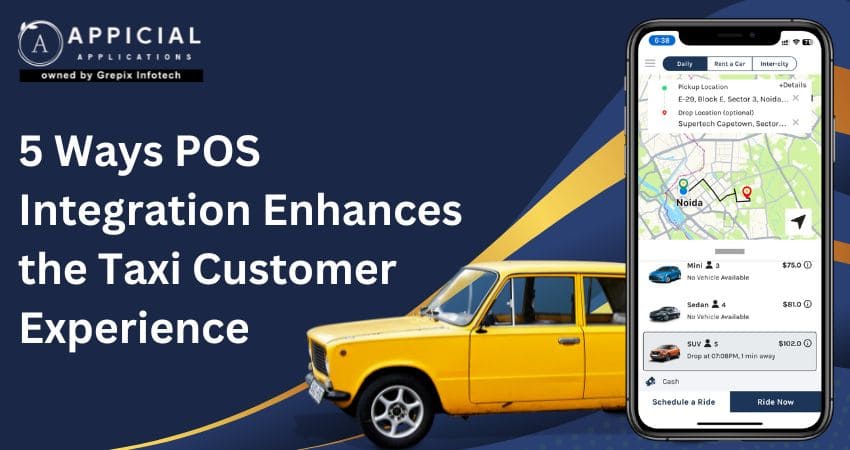
5 Ways POS Integration Enhances the Taxi Customer Experience
The taxi industry has evolved significantly with modern technology, making rides more convenient and secure for passengers. One of the biggest advancements in recent years is Point of Sale (POS) integration, which allows taxis to accept digital payments seamlessly. Gone are the days of scrambling for cash or worrying about payment fraud POS systems provide a hassle-free experience that benefits passengers and drivers.
POS integration has revolutionized the taxi industry by making payments faster, safer, and more convenient for passengers. Whether it's quick transactions, fraud protection, transparent pricing, or better accessibility, modern POS systems significantly improve customer satisfaction.
As the world moves towards a cashless society, taxi companies that embrace POS technology will stand out, attract more customers, and create a superior travel experience. Investing in POS integration is no longer an option, it’s a necessity for taxi businesses looking to thrive in the digital era. By integrating secure, fast, and efficient POS solutions, taxi companies can improve service quality and enhance the overall customer experience. Let’s explore the five ways POS integration enhances the taxi customer experience.
The taxi industry has evolved with modern technology, and POS integration has transformed payment processing, making transactions faster, safer, and more convenient for passengers. POS systems eliminate cash handling, reduce fraud, and provide multiple payment options, enhancing customer experience. With features like EMV chip security, encryption, real-time receipts, and digital fare transparency, passengers enjoy a seamless and trustworthy ride. As the world shifts toward a cashless economy, taxi companies must adopt POS technology to stay competitive. Appicial Applications leads this transformation, offering secure and efficient POS solutions that help taxi businesses enhance service quality and customer satisfaction.
5 Ways POS Integration Enhances the Taxi Customer Experience
Let’s explore the five ways POS integration enhances the taxi customer experience.
In today’s fast-paced, digitally driven world, customers expect more than just a ride from a taxi app they expect convenience, security, and speed at every touchpoint, especially when it comes to payments.This is where POS integration (Point-of-Sale integration) becomes a game-changer in taxi app development. Whether you’re building a new Uber clone app or enhancing an existing ride-hailing platform, integrating a modern POS system can dramatically improve the passenger experience. From contactless payments and digital wallets to in-car card readers, POS integration allows riders to pay however they prefer—quickly, easily, and securely.
But it's not just about making payments faster. For taxi operators and developers alike, POS integration opens the door to better revenue tracking, reduced payment errors, enhanced driver satisfaction, and stronger customer retention.
As on-demand transportation services continue to evolve, offering flexible and frictionless payment options is no longer a luxury it’s a necessity.
In this blog, we’ll explore how POS systems are revolutionizing taxi app development, the benefits they offer to riders and drivers, must-have features to include, and the key challenges to watch out for.
Whether you're a mobile app development agency, a startup, or a seasoned fleet operator, understanding POS integration could be the edge your taxi booking application needs in a highly competitive market.
Understanding POS Integration in Taxi Apps
POS integration refers to the seamless incorporation of payment processing systems within taxi apps, which may enable passengers to make digital payments effortlessly. This integration supports various payment methods, including credit/debit cards, mobile wallets, and contactless payments, thereby eliminating the need for cash transactions.
Benefits of POS Integration in Taxi App Development
1 Streamlined Payment Processes
With POS integration, passengers can complete transactions swiftly, reducing wait times and enhancing convenience. This efficiency is particularly beneficial during peak hours or in high-traffic areas where time is of the essence.
2 Enhanced Security Measures
Modern POS systems employ advanced security protocols, such as EMV chip technology and end-to-end encryption, to safeguard sensitive payment information. This ensures that both passengers and drivers are protected against potential fraud or data breaches.
3 Improved Transparency and Trust
By providing detailed digital receipts and transparent fare breakdowns, POS integration fosters trust between passengers and service providers. Passengers can easily track their expenses and verify charges, leading to increased satisfaction and loyalty.
4 Accessibility for a Broader Audience
POS systems accommodate a wide range of payment options, making taxi services more accessible to international travelers and those who prefer cashless transactions. This inclusivity can expand the customer base and enhance the global appeal of ride-hailing services.
Top 5 Ways in Which POS Integration can Enhance the Taxi Customer Experience
1Faster and Hassle-Free Payments
One of the biggest frustrations passengers face is delayed payments at the end of their ride. Searching for cash, dealing with change, or waiting for a slow card transaction can be inconvenient, especially for those in a hurry.
How POS Integration Helps
- Instant Transactions POS systems process payments within seconds, allowing passengers to complete rides without delays.
- Multiple Payment Options Passengers can pay using credit/debit cards, mobile wallets (Apple Pay, Google Pay), and contactless payments, making the experience seamless.
- Reduced Errors Automated transactions eliminate miscalculations or incorrect charges that sometimes happen with manual payments.
With a smooth and efficient POS system, passengers enjoy a stress-free payment experience, leading to higher satisfaction and repeat customers.
2Enhanced Security and Fraud Prevention
Passengers are often concerned about payment security, especially when using taxis in unfamiliar locations. Traditional cash payments can lead to theft risks, and outdated card processing systems can be vulnerable to fraud.
How POS Integration Helps:
- EMV Chip Card Technology: Prevents card cloning and skimming, making card payments safer.
- End-to-End Encryption (E2EE): Ensures that passenger payment data is securely transmitted and cannot be intercepted by hackers.
- Instant Payment Confirmation: Real-time receipts are sent to passengers via email or SMS, providing them with evidence of payment and minimizing disputes.
With these advanced security features, passengers feel more confident using taxis without worrying about financial risks.
3Greater Transparency and Trust
A common complaint among taxi passengers is unclear pricing or overcharging. In some cases, drivers may demand additional charges, leading to disputes and a negative customer experience. POS integration eliminates these issues by ensuring full pricing transparency.
How POS Integration Helps:
- Clear Fare Breakdown: The POS system calculates fares automatically based on distance, time, and additional charges, ensuring accuracy.
- Digital Receipts: Passengers receive a detailed receipt via SMS or email, making it easy to track expenses.
- Fixed Pricing for App-Based Rides: Many taxi services now integrate POS with ride-hailing apps, ensuring passengers are charged the exact amount displayed in the app.
By promoting honesty and transparency, POS integration builds passenger trust, encouraging them to choose taxis over competitors.
4Improved Accessibility and Convenience
Not everyone carries cash, and some passengers may not have local currency when traveling. A lack of payment options can make taxis inconvenient, especially for tourists and business travelers.
How POS Integration Helps:
- Accepts International Cards: Passengers can pay using Visa, Mastercard, Amex, and other international cards, making taxis more accessible to travelers.
- Supports Mobile Payments: Many modern POS systems accept Apple Pay, Google Pay, and NFC payments, catering to tech-savvy customers.
- Quick Splitting of Fares: If multiple passengers are sharing a ride, POS systems allow them to split the fare easily without needing to exchange cash.
By offering multiple payment options, taxis become more convenient and appealing to a broader customer base.
Also Read: How POS Integration is Revolutionizing the Taxi Industry
5Better Customer Experience and Loyalty
A smooth and positive experience keeps customers coming back. When passengers have a seamless ride, secure payment, and a hassle-free checkout process, they are more likely to use the same taxi service again.
How POS Integration Helps:
- Loyalty Programs & Discounts: Some POS systems integrate with customer loyalty programs, allowing passengers to earn points, discounts, or cashback.
- Automated Invoicing for Business Travelers: Business passengers can get automated invoices for expense tracking, making taxis a preferred choice over other transport options.
- Customizable Tipping Options: POS devices offer easy tipping options, allowing passengers to reward good service instantly.
With enhanced convenience and rewards, passengers are more likely to choose taxis over competitors like rideshare services.
Challenges and Considerations in POS Integration for Taxi Apps
While POS integration in taxi app development is undeniably a game-changer for improving customer experience and operational efficiency, it comes with its own set of challenges and considerations that developers, taxi business owners, and stakeholders must take seriously. Overlooking these factors can lead to technical hiccups, security vulnerabilities, and ultimately, dissatisfied users. Let's dive deeper into the key challenges and how they can be managed effectively.
1 System Compatibility and Integration Complexity
One of the biggest hurdles in POS integration is ensuring that the POS system is fully compatible with the existing taxi app infrastructure. Many ride-hailing platforms are built on customized architectures with specific backend logic, which may not align seamlessly with third-party POS hardware or software.
Key Issues Include:
- Integrating POS APIs into the backend without disrupting existing functionalities.
- Ensuring synchronization between real-time fare calculation and the POS payment module.
- Compatibility with multiple mobile platforms (iOS, Android) and different device models.
- Data interception during transactions.
- Malware attacks on mobile POS devices.
- Unauthorized access to stored payment information.
- Fraudulent transactions or chargeback scams.
- Connectivity issues between the app and the POS terminal.
- Hardware malfunctions in mobile POS devices.
- Software bugs occur after updates or during heavy load.
- Compatibility issues with newer devices or OS versions.
- Integration with cryptocurrency wallets.
- Voice-assisted payments (via Siri, Google Assistant).
- Biometric authentication for payments.
- BNPL (Buy Now, Pay Later) options.
- All-in-One Experience: A modern taxi app with POS integration doesn’t just handle bookings. It calculates fares in real-time, processes payments securely, and settles earnings with drivers—all from a single platform.
- Smarter Uber Clone Apps: If you’re launching an Uber clone app, built-in POS systems can help you match what the big players offer. It gives your app a polished feel and boosts your chances in the crowded ride-hailing space.
- Clearer Revenue Tracking: When payments go digital, so does your reporting. Businesses get access to real-time insights, helping them make smart decisions, manage earnings, and grow faster.
Solution:
To overcome this, developers must perform extensive compatibility testing and ideally work with POS vendors who offer SDKs or APIs tailored for taxi app development. Using modular architecture during app development can also make future integrations smoother and less time-consuming.
2 Data Security and Regulatory Compliance
Since POS integration involves handling sensitive user data, including card information and personal details, security becomes a top priority. A security breach not only jeopardizes passenger trust but can also lead to regulatory penalties and long-term reputational damage.
Security Threats Include:
Solution:
To mitigate these risks, developers must implement end-to-end encryption (E2EE), tokenization, and EMV compliance. Additionally, apps must adhere to PCI-DSS (Payment Card Industry Data Security Standard) regulations. Regular security audits, penetration testing, and real-time monitoring can further strengthen data protection.
3 Ongoing Technical Support and Maintenance
Taxi app businesses operate 24/7, and any downtime in payment processing due to POS system failure can disrupt the service and frustrate customers. This means that integrating the POS system is not a one-time task—it requires continuous support and maintenance.
Common Support Issues Include:
Solution:
Ensure that the POS vendor provides reliable technical support, ideally with 24/7 assistance and a dedicated support team. Developers should also build a robust logging and error-reporting system into the taxi app so that issues can be diagnosed and resolved quickly. Regular maintenance cycles and updates should be scheduled proactively.
4 Evolving Payment Trends and Consumer Expectations
Digital payment preferences evolve rapidly. What’s trending today (e.g., contactless payments or digital wallets like Apple Pay) may be outdated tomorrow. Customers now expect personalized, instant, and flexible payment options within their ride-hailing experiences.
Emerging Trends Include:
Solution:
Taxi businesses and developers must stay ahead by continuously researching market trends, updating their POS integration features, and being ready to support emerging technologies. Working with scalable and API-friendly POS providers ensures that adapting to new trends won’t require a complete overhaul.
POS Integration in Taxi App Development & Uber Clone Solutions
In the fast-moving world of taxi app development, staying ahead means more than just launching an app—it’s about creating a smooth, reliable experience from start to finish. That’s where POS integration comes in. By building payment systems directly into the app, companies make it easier for riders to book, pay, and get digital receipts—all in one place.
Why POS Integration Makes a Real Difference
As more people turn to on-demand transportation, adding POS features to your Uber clone or taxi app isn’t just a nice-to-have—it’s a must. It improves the rider’s journey, streamlines the driver’s workflow, and gives business owners a clear view of their revenue.
Conclusion
The adoption of POS integration in the taxi industry has revolutionized payment processing, offering passengers a faster, safer, and more convenient way to pay. From instant transactions and enhanced security to transparency and accessibility, modern POS systems significantly improve the customer experience, fostering trust and loyalty.
As a leader in taxi app development, Appicial Applications is at the forefront of this transformation. By providing cutting-edge, secure, and efficient POS solutions, Appicial empowers taxi companies to streamline operations, boost customer satisfaction, and stay competitive in an increasingly cashless world. Investing in POS integration today is the key to a more profitable and future-ready taxi business.
FAQs
Looking out to start your own venture like Uber ? Try out our HireMe Taxi Uber Clone, the easiest way to kick-start your taxi business.
Author's Bio

Vinay Jain is the Founder at Grepix Infotech and brings over 12 years of entrepreneurial experience. His focus revolves around software & business development and customer satisfaction.
Back to blog list




